Taxidermy4Cash.com
Taxidermy in the UK
We are always very interested in Purchasing Victorian Taxidermy, please respond via this on-line form of what you have for sale. HERE
Edward Gerrards, London Taxidermists, by David Chapman.
Edward Gerrard Snr was employed by the British Museum (Natural History) as the resident Taxidermiast from 1841 to c1890. During this period he mounted some specimens for Charles Darwin. In fact, Darwin and Gerrard were friends, and a species of shark, discovered by Darwin was reputedly named after Edward Gerrard, although I have not yet been able to substantiate this. Until the 1960's, a signed copy of Darwin's second book, dedicated to Edward Gerrard was held in the company library. Alas, this was later sold to a book dealer, and no further information regarding its whereabouts has yet been forthcoming.
![gerrardsitting[1].JPG](gerrardsitting[1].JPG)
Charles Gerrard surrounded by the firm's work .
![gerrardsitting2[1].JPG](gerrardsitting2[1].JPG)
The firm's work .
![SeaTrout1AdjSm[1].JPG](SeaTrout1AdjSm[1].JPG)
Carved Sea Trout on Oak board.
![SeaTrout1AdjLabel[1].JPG](SeaTrout1AdjLabel[1].JPG)
Carved Sea Trout on Oak board. Data from the above item. Also in an envelope on the back contains the follwoing: which has fish scales and a letter from an expert to the fisherman saying the fish was an 8 year old male that had spawned 5 times.
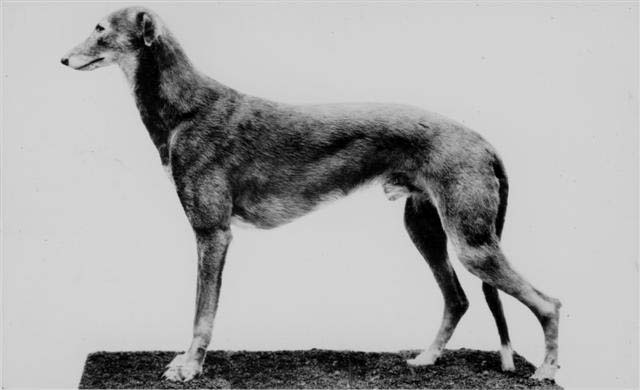
The famous "Mike the Miller", greyhound, mounted and preserved by Gerrards of London.Just week's short of his thirteenth birthday, Mick the Miller, the world's most famous greyhound, died in his sleep in his kennel, in Wimbledon. He had won 46 of his 61 races between 1928 and 1931, and, after being stuffed and mounted, was put on display in the Natural History Museum in London after his death. In 1995, he moved to the less glamorous location of the Walter Rothschild Zoological museum in Tring. Mick the Miller's display, which stands in the household dogs' section alongside another famous greyhound, Ballyregan Bob.
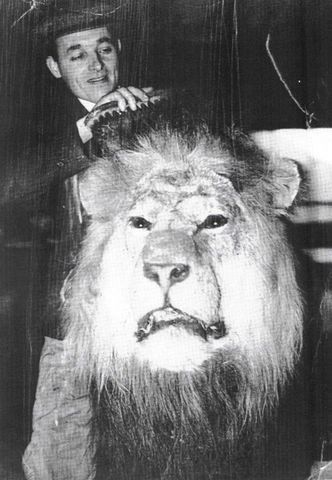
Fredderick Greenwood, circa 1940, working on a Lions head from Gerrards.
![fgreenwood2 [640x480].jpg](fgreenwood2 [640x480].jpg)
Fredderick Greenwood, circa 1940, working on a Lions head from Gerrards.
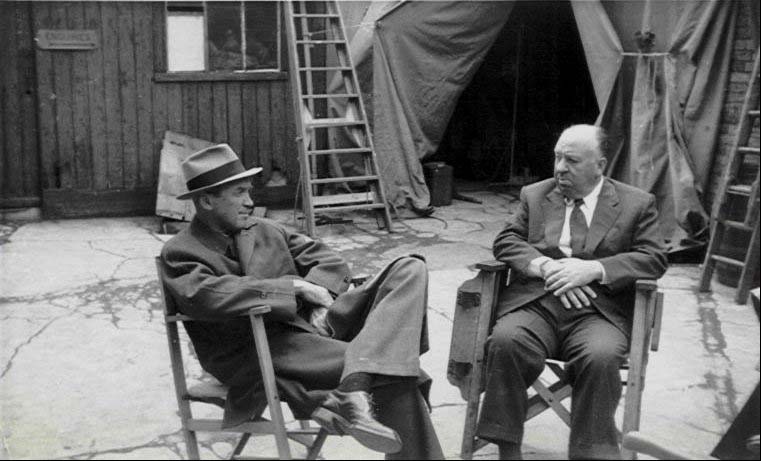
James Stewart filing at the Gerrards premises in 1955. The film was "The Man who knew too much" by Alfred Hitchcock.
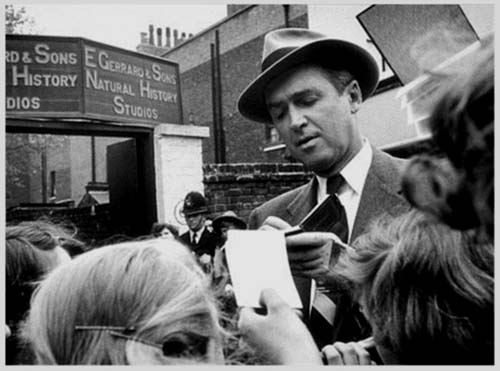
James Stewart filing at the Gerrards premises in 1955. The film was "The Man who knew too much" by Alfred Hitchcock.
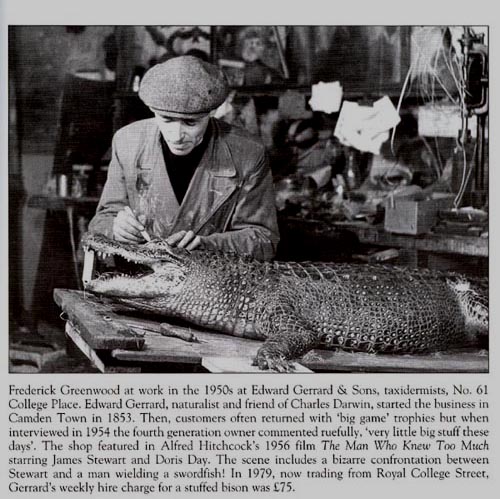
Fredderick Greenwood, circa 1940, working on a Crocodile from Gerrards.
The commercial firm of Edward Gerrard's was founded in 1853. The business was, and remained for more than a century, a family concern. By family tradition, the eldest son f the eldest son was always named Edward, a process that only faltered when Edward Gerrard, great great grandson of the company founder did not produce a son, but instead two daughters, Elizabeth (born 1930?) and Audrey (born 1931). As a result, Edward Gerrard's younger son, Charles, named his eldest son Edward (born 1933), who became Managing Director of the firm until it finally closed down in the late 1960's (apart from the hire business). Mr Edward 'Ted' Gerrard currently lives abroad, where he has pursued a career as an ornithologist.
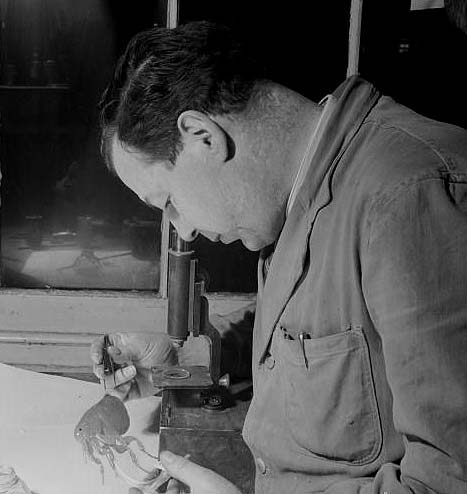
Science exhibits were also their stock in trade. Here they are reproducing a scale model of a flea.
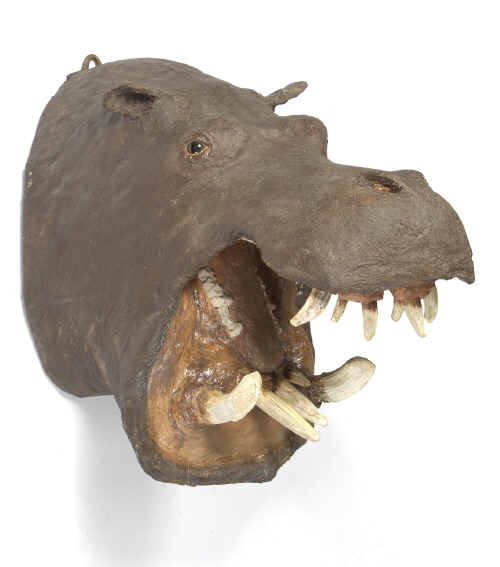
Hippo head by Gerrards.
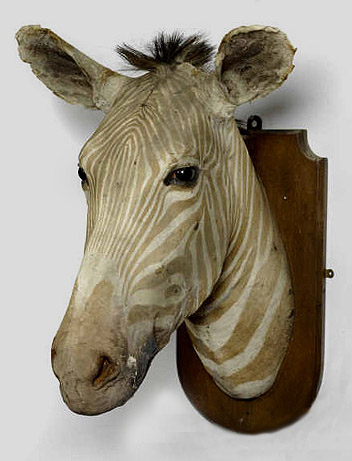
Grevy's Zebra head by Gerrards.
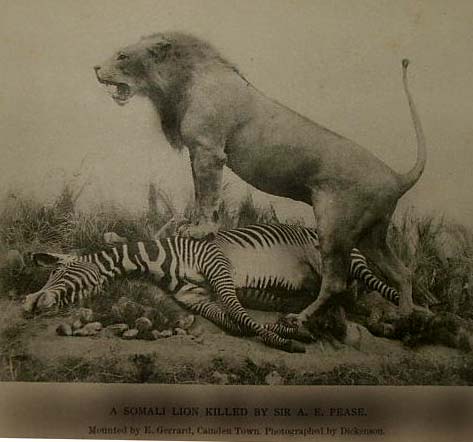
Lion and Zebra by Gerrard's of London. This item once took pride of place at the Dorman museum. See below, but now these days it is without the Zebra.
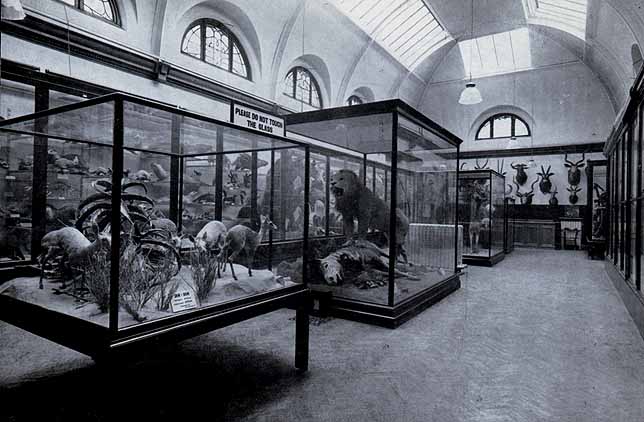 The Dorman Museum.
The Dorman Museum.
![gerrardmuskoxen[1].JPG](gerrardmuskoxen[1].JPG)
Musk Oxen and Polar Bear by Gerrard's of London.
Their first business premises appear to have been at 54 Queen's Road, Camden Town, London, from where they moved to 60 College Place (later 61), in the early 1900's. A few years ago I corresponded with a relative of one of the Taxidermist's (Frederick Greenwood) who worked at Gerrard's in the 1950's. According to her, the firm ceased taxidermy around 1961-2, after which it became a film hire company, with premises at 85 Royal College Street. This has since been confirmed by Edward 'Ted' Gerrard (see below). In fact, the firm split into two shortly before the second world war.
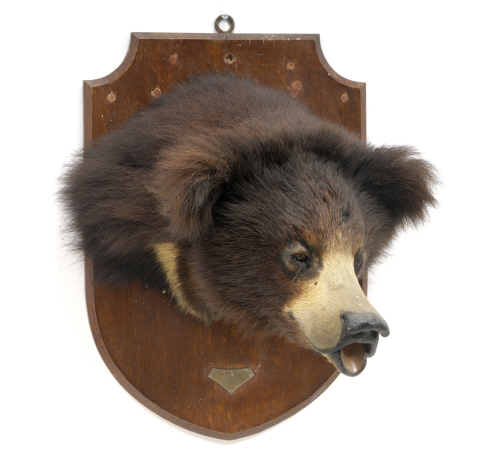
Sloth Bear's head by Gerrards.
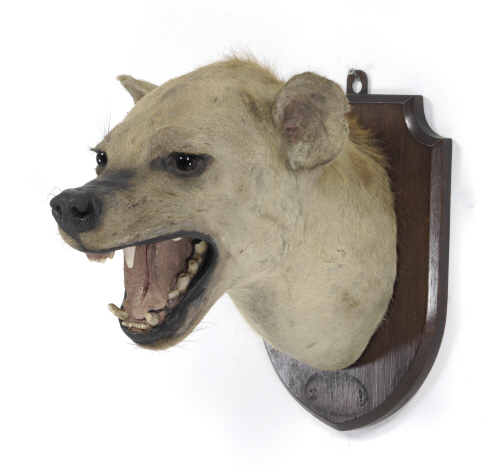
Hyena head by Gerrards.
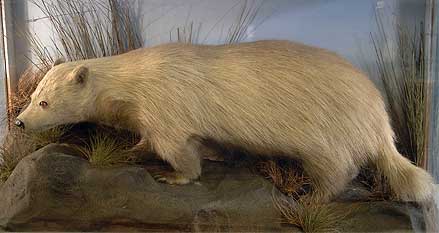
Albino Badger by Gerrards.
![gerrards001[1].JPG](gerrards001[1].JPG)
Invoice from Gerrards, just prior to the company closing down.
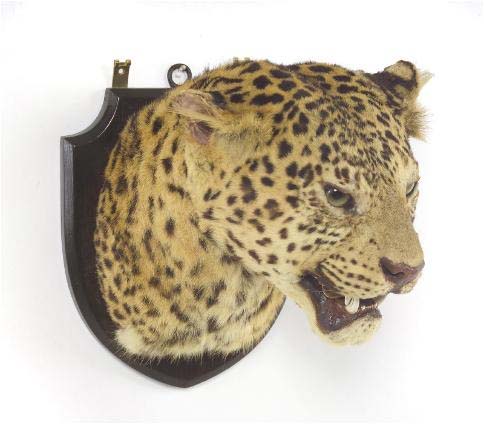
Leopard head by Gerrards.
The biology section moved to Pentonville and in the 1960's an additional move was made to Worthing. This side of the business was finally bought out by a large educational supply company. Post war, the biology section was the ost profitable side of the business. The taxidermy side was by then owned by cousins of the main EG family line, headed by Harry. When he died at the end of the war, Charles & Edward bought it back from the inheritors, who lived in Rhodesia (now Zimbabwe).
The brothers, Charles & Edward, had both worked in the aircraft industry during the war. Although Charles had worked for the family firm prior to this, Edward had been a professional Royal Navy engineer. In fact, both had been mariners at some point, having been sent to Dartmouth Marine Academy after world war one by their mother. Initially they had all lived together at Hilldrop Road in Camden Town.
![gerrardsitting1[1].jpg](gerrardsitting1[1].jpg)
Trout by Gerrards.
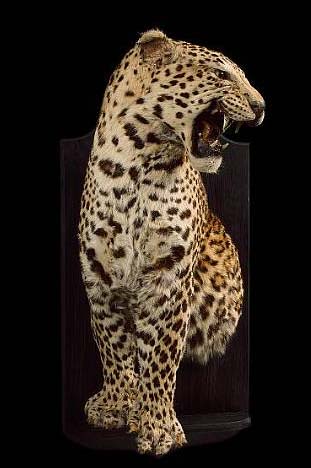
Leopard by Gerrards.
In the early 1960's, Camden Council decided to redevelop College Place. Gerrard's, by now a limited company, had a 99 year lease from the church commissioners, which was due for renewal. The firm accepted Camden's offer to relocate to an ex-veterinary premises at 1 Ferdinand Place in Chalk Farm NW1. These premises were not big enough to house all three of the remaining businesses. The hire company, specialising in supplying specimens for film and TV work, renovated and moved into the old store in Royal College Street. The taxidermy business itself was no longer commercially viable and so came to a natural and rather sad end (1965). The other remaining business, floor coverings (goat/sheep skins etc), was eventually put into liquidation (circa 1967/8) due to a bill of exchange swindle by a city broker. The perpetrator was subsequently jailed, but in the process, brought down a number of well established fur businesses, including Gerrard's, with whom he had dealt for over 40 years. Edward & Charles retired at this point. Sadly, Charles lost his house in North Finchley in the process, having acted a s a personal guarantor to the bank.
![gerrardsitting3[1].jpg](gerrardsitting3[1].jpg)
The firm's work .
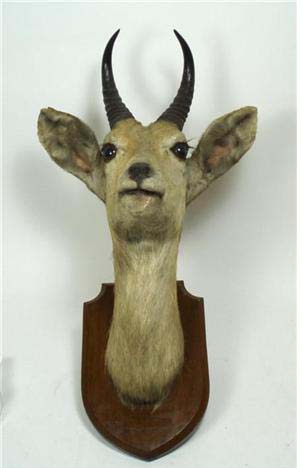
Reedbuck.
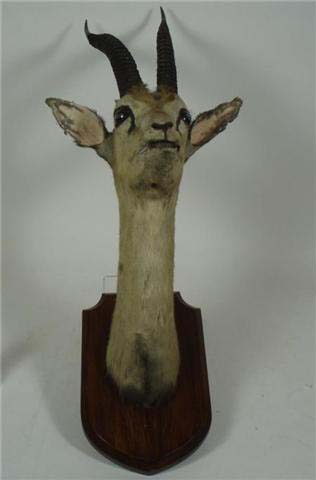
Gazelle.
It is well known that Edward Gerrard & Son's were the taxidermist's who mounted the famous greyhound 'Mick the Miller'. Less well known is that the 1956 Alfred Hitchcock film, The Man Who Knew Too Much' contains sequences shot at Gerrard's premises. It offers an interesting, if relatively brief, insight as to what the main workshop looked like in the 1950's. I recently obtained a photograph of James Stewart & Hitchcock sitting in what was the back yard of Gerrard's! According to Ted Gerrard, the firm effectively closed down for a week, while Hitchcock directed and the staff watched the master of film at work.
In the scene itself, James Stewart is seen getting out of a taxi in Royal College Street and then entering a taxidermists premises called Ambrose Chappell. An elaborate chase then ensues, with Stewart eventually being harassed by a man wielding a swordfish! In the film, the premises are listed as being at 61 Burdett Street (we know this as Stewart looks up the address in the phone book). Interestingly, they kept the correct street number, even though they changed the road name from College Place.
In their trade catalogues, Gerrard's listed a number of 'Achievements & Personalities', including 'The Basking Shark, 30 feet long, featured in the film 'Man of Arran', 'Huberta, the famous Hippopotamus, which wandered from north to South Africa' and the skeleton of a large 'Blue Whale, 92 feet long, now hanging in the Whale Hall at the Natural History Museum'. In the case of the latter, Ted Gerrard recalls his father taking him to the museum and when he had a sufficient audience, informing him the whale was incomplete! He then proceeded to produce the last vertebrae from his pocket, to the amusement and delight of those gathered.
Edward Gerrard's were represented at the Festival of Britain of May-September 1951 by a Megatherium (Giant Sloth). This extinct animal, approximately 18 feet long and 13ft high, was equal to the elephant in terms of bulk. It had massive hind limbs, a head with a long muzzle and no front teeth. It was mainly to be found in South America. The exhibit, nicknamed 'The Thing', consisted of a life sized model, one side of which showed the complete animal with fur, the other, the exposed skeleton.
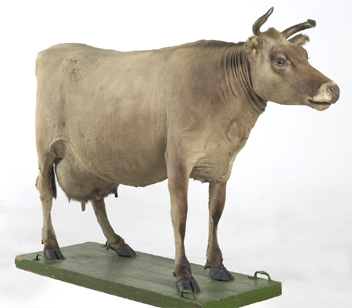 Promotional Bovine for the New Zealand Dairy industry.
Promotional Bovine for the New Zealand Dairy industry.
![pmeg1 [640x480].jpg](pmeg1 [640x480].jpg) A recent book on Edward Gerrard & Son by Pat Morris has been produced also.
A recent book on Edward Gerrard & Son by Pat Morris has been produced also.
Though perhaps marginally less well known than the internationally renowned taxidermy firm of Rowland Ward, the company were highly regarded, and were clearly very adept at marketing their business. Their trade labels, advertisements and catalogues were well designed, even by todayís standards, and suggest a firm brimming with confidence. Much of their work is labelled, and where a trade label is absent, their work is usually distinctive enough for it still to be recognisably their work. This particularly applies to their hunting trophies, where the distinctive quality, shape and style of their shields, as well as the quality and form of the mounts themselves, usually leaves little doubt as to its origin.
As taxidermists, naturalists and artists, Edward Gerrard & Sonís have left us a fine legacy. I have little doubt, that as long as we retain an interest in the natural world, recognition for the quality of their work , and respect for their achievements will only increase.
Taxidermy4Cash does not undertake taxidermy, rather we are collectors of
other peopleís work, both current and historical we also offer web hosting,
a search engine submission service and increasingly one of the larger
article resource banks on the net. So if your keen to learn about Taxidermy
etc, then you know where to look.
We are always interested to here about new resource, if you feel a resource
should be listed here then please contact us.
|
ITEMS
WANTED. Please respond via this on-line form HERE
with a description of what you have for sale.
[HOMEPAGE]
Taxidermy Links.
Please double click on the Taxidermy link icon below.
Taxidermy
Links
|
|


![fgreenwood2 [640x480].jpg](fgreenwood2 [640x480].jpg)












![gerrardsitting1[1].jpg](gerrardsitting1[1].jpg)

![gerrardsitting3[1].jpg](gerrardsitting3[1].jpg)



![pmeg1 [640x480].jpg](pmeg1 [640x480].jpg)